Residents stay cautiously optimistic toward epidemic control in Japan
By Xing Xiaojing, Leng Shumei and Xu Keyue Source:Global Times Published: 2020/3/15 19:53:40 Last Updated: 2020/3/16 4:57:06
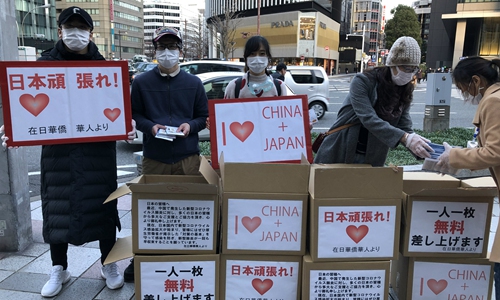
Overseas Chinese in Japan voluntarily give away masks to the Japanese public near the Nagoya Station, Japan on Thursday, reminding the public to pay attention to protecting against the coronavirus. Photo: cnsphoto
Japanese residents and experts expressed cautious optimism about the control of the COVID-19 outbreak in the country, which on Sunday reported 1,514 cases and 31 deaths (including those related to cruise ship Diamond Princess).
Japan approved a limited law measure on Friday that enables Prime Minister Shinzo Abe to declare a state of emergency should he feel it necessary, to stop the spread of COVID-19, Kyodo News reported.
On Saturday, Japanese Prime Minister Shinzo Abe said there is not an immediate need to declare a state of emergency and the country would continue to prepare for the Tokyo Summer Olympics and Paralympics despite the ongoing COVID-19 pandemic, media reported.
Abe said Japan has avoided a nation-wide surge in infections amid reports that some clusters and small groups have been hit hard with the virus.
Abe also said that it was not necessary to declare a state of emergency at this point, but now is not the time to relax all-out efforts and called upon the public to avoid crowded and closed areas, Japanese media reported.
Some Chinese experts predicted in February that Japan would follow China as the second country to experience a massive outbreak of COVID-19.
But after headlines surrounding the 697 infected patients on the disease-stricken cruise ship, the predicted explosive surge in cases did not arrive.
There were 63 new confirmed COVID-19 cases reported in Japan on Saturday, the biggest number since the outbreak excluding those linked to the ship, according to Japanese media NHK News.
Why the line of new infections in Japan has revealed a relatively easy curve? Japan's virus prevention has experienced four stages, and has adjusted measures in accordance with the outbreak and the country's condition, using China's experiences for reference to battle the virus.
Japanes`e's hygiene habits and other national characteristics have helped the public to maintain calm in face of a pandemic in keeping pace with the government's strategy.
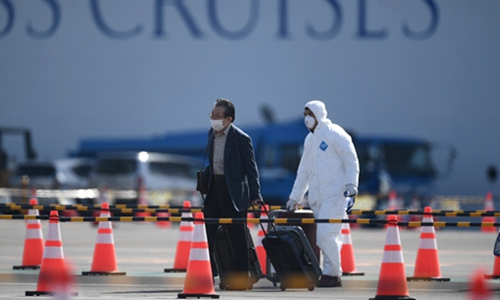
A passenger (left) disembarks from the Diamond Princess cruise ship - in quarantine due to fears of the novel coronavirus - at the Daikoku Pier Cruise Terminal in Yokohama on Wednesday. Photo: AFP
Four stages
The first phase is at the beginning of the outbreak, during which the Japanese government adopted "defensive measures" to prevent imported infections.
On January 24, the Japanese government issued a travel alert to those who were going to Hubei Province, where the first coronavirus case was reported.
On January 29, the first chartered flight was sent to Hubei Province to bring home Japanese nationals who stranded there after a provincial lockdown was ordered.
Upon arrival, two passengers refused a coronavirus screening test. Shortly afterward, the Japanese government announced that COVID-19 tests would be mandatory for all passengers boarding chartered flights.
On February 1, Japan denied entry to travelers who had been to Central China's Hubei Province two weeks prior to their arrival, including those with passports issued by Hubei provincial authorities.
On February 3, when the Diamond Princess cruise liner, where COVID-19 cases were reported, arrived in Yokohama, passengers underwent a 14-day mandatory quarantine.
On February 6, a cruise liner out of Hong Kong that had one suspected infected passenger was refused for entry to Japan in accordance to local entry and exit regulations.
A week later, foreign nationals who had visited Zhejiang Province or whose passports were issued by the province would be denied entry.
On February 13, the first human-to-human transmission outside of China occurred in Japan. Health Minister Katsunobu Kato said changes would be made according to the epidemic and it should be handled similar to a crisis.
The Japanese government entered its second phase by rolling out a series of new measures.
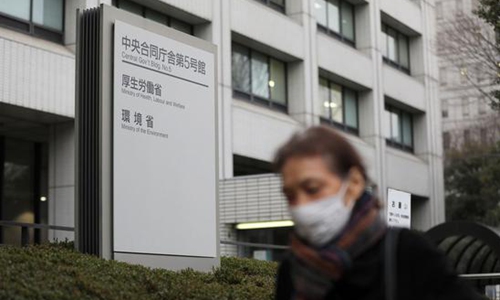
A pedestrian wearing a face mask passes by the office building of the Ministry of Health, Labour and Welfare in Tokyo, Japan, Feb. 25, 2020. Photo: Xinhua
On February 13, the Japanese government issued the first emergency deal, allocating $142 million funds to support tests, quarantine, and treatment.
Prime Minister Shinzo Abe organized officials and epidemiologists to discuss the situation on February 16, and expanded virus testing and medical consultation channels.
Japanese Ministry of Health, Labor and Welfare published a manual on February 17, asking those with flu symptoms or anyone with a fever last over four days above 37.5C to stay indoors, call hotlines, and visit doctors at designated hospitals.
Liu Junhong, a research fellow at the China Institute of Contemporary International Relations in Beijing, told the Global Times on Sunday that such measures could stop cross-infections due to misjudgments as non-infected people could avoid being infected with the virus when visiting a doctor.
Liu said Japan learned the measures from China's experiences, but China implemented the strategies at community level, monitoring residents' health and travel history, and sent people with symptoms to designated hospitals. The work in China was mostly done online, which was more convenient than using a telephone, he added.
On February 24, Japanese experts announced the following one to two weeks would be critical to see whether the epidemic had either been curbed or was spreading. The move signaled the third phase of quick adjustment in polices.
On February 25, authorities issued a guideline addressing COVID-19, which states that despite clustered infections, there was no large-scale epidemic. The guideline asked hospitals to treat critical patients and advise others to recover at home.
The following day, Abe announced that national cultural and athletic activities would be canceled and Japan would increase face mask production.
On February 27, it was announced that testing for COVID-19 would be covered by health care.
On March 3, Japanese government allocated $21 million for face mask manufacturers to purchase necessary materials.
Japanese government announced visas issued to Chinese and South Koreans would be invalid beginning March 9. Inbound travelers from either country would be quarantined for 14 days, and all flights would only be allowed to land at two airports in Tokyo and Osaka.
This policy, with economic risks, marked the fourth phase: strict control of people's movement.
On March 13, an act was passed that gives the prime minister the power to declare a state of emergency. If a national emergency is declared, the government can order companies to produce certain supplies or requisite civil facilities. The move created a legal basis for future political orders.
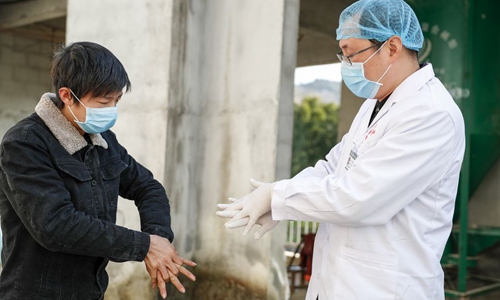
Photo: Xinhua
Good healthy habits help
Liu Hongjun said that the limited increase in confirmed cases showed the Japanese government's necessary proactive response to the epidemic before the July Tokyo Olympic Games.
He argued that Japan did not conduct a national lockdown as the country's epidemic was not that serious and, meanwhile, Japanese people were familiar with disasters and showed a strong sense of organization and they cooperated with the government at such times.
"Japanese government apply different measures at different stages of the epidemic, which accords with the country's actual situation at that time such as epidemic scale and transmission speed. If the government launched the highest-level measure at the very beginning, it would trigger public panic," Liu Hongjun said, noting that Japanese government has been adjusting measures against the epidemic according to the changing situation.
Chinese living in Japan told the Global Times that local residents' healthy habits also played a role in helping the country dodge a serious outbreak.
"They always pay attention to washing their hands and rinsing their mouths in daily life, and also wear masks in flu and pollen seasons," a University of Tokyo student who gave the surname Meng told the Global Times on Sunday.
Meng said Japan applied a "passive strategy" involving limited nucleic acid tests and home quarantine, a similar approach that certain European countries are now taking.
Sun Wenwen (pseudonym), a Chinese woman living in Tokyo, said her company canceled all business trips and prepared masks for employees in early February.
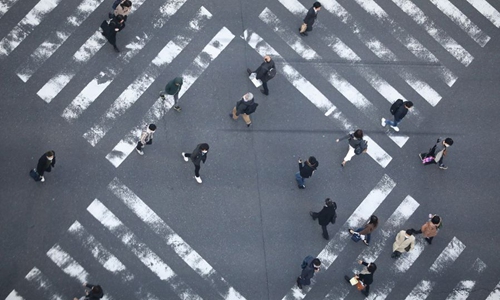
Pedestrians wearing masks walk in the street at Ginza in Tokyo, Japan, on March 6, 2020. Photo: Xinhua
Cautiously optimistic
Despite early successes, Japanese experts and residents remained cautious about the future course of the epidemic in the country.
The number of COVID-19 cases seemed small in Japan as hospitals only accepted critical patients, which brought uncertainty to the actual infected population, Tomoo Marukawa, a professor at Tokyo University, told the Global Times on Sunday.
Oishi Kazunori, director of the health research institute in Toyama, agreed with Marukawa and said Japan has revealed slow growth in confirmed cases compared to South Korea, Iran and Italy, but the number has not stopped increasing.
Kazunori told the Global Times on Sunday that effectiveness of Japan's measures should not be judged by comparison to other countries but rather on themselves.
"It still requires time to observe the effectiveness of suspending schools and restricting massive events," Kazunori said.
Japanese media reported on Thursday that it may be a long-term battle due to lack of knowledge on COVID-19, including its characteristics and transmission methods. Development on vaccine and drugs should also be accelerated.
Japanese media noted that there would be many vital events in April, when the new year starts in the country. Current measures probably could not last long, considering their influence on society and the economy.
Although the epidemic had been postponed, any slacking off could bring a new peak, warned Kazuyuki Aihara, an expert in biological information systems at the University of Tokyo.
Kazunori Tomono , an infection control and prevention expert at Osaka University Hospital, estimated that the epidemic would probably be similar to a seasonal flu that usually lasts six months.
But it was hard to predict an end due to a lack of knowledge about the novel coronavirus, he told Japanese media Nikkei.
Liu Yuping (pseudonym), a Chinese graduate student at Waseda University in Tokyo, told the Global Times on Sunday that she worried as the country relied largely on individual protection without systematic prevention and control measures.
A shortage of materials including masks was also alarming, Liu Yuping said.
Liu Hongjun also pointed out a problem of "excessive accuracy" of medical resources in Japan.
Despite the huge talent in infectious diseases so that Japanese colleges and institutes can promote vaccine and drug development in emergency situations, the country is too accurate in calculating hospitals' capacity to spare emergency spaces.
The problem has been revealed in 2009 during the flu epidemic in Japan, but was forgot after that. Before build some medical resources for preparation, Japanese government would usually consider: when would them be used? Was it a waste of taxes? So this time, the issue is still not fixed in the COVID-19 epidemic, according to Liu Hongjun.
The problem was revealed in 2009 during the flu epidemic in Japan but has since been forgotten. Before building medical resources, the Japanese government normally asks when they will be used. Was it a waste of taxes? The problem reoccurred amid the COVID-19 epidemic, according to Liu Hongjun.
Posted in: SOCIETY,ASIA-PACIFIC